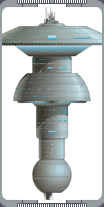Most Federation space stations, such as Spacedock, are huge structures that dwarf the average starship.
 The Federation's primary spacedock is the massive station orbiting Earth, providing service facilities for
Starfleet vessels. The USS Enterprise NCC-1701 returned to
Spacedock in 2285 following the battle with Khan in the Mutara Nebula. At the time, the ship was scheduled to
be decommissioned, but Admiral James Kirk stole the Enterprise from Spacedock in an effort to rescue
Captain Spock's body on the Genesis planet. Also stationed at Spacedock at the time was the
USS Excelsior NX-2000, undergoing tests of its experimental
transwarp drive. In an alternate reality created by a timestream, the
Yellowstone-class runabout prototype USS Yellowstone
NX-74751 was stolen from Spacedock in 2372 by Ensign Harry Kim and Tom Paris.
The Federation's primary spacedock is the massive station orbiting Earth, providing service facilities for
Starfleet vessels. The USS Enterprise NCC-1701 returned to
Spacedock in 2285 following the battle with Khan in the Mutara Nebula. At the time, the ship was scheduled to
be decommissioned, but Admiral James Kirk stole the Enterprise from Spacedock in an effort to rescue
Captain Spock's body on the Genesis planet. Also stationed at Spacedock at the time was the
USS Excelsior NX-2000, undergoing tests of its experimental
transwarp drive. In an alternate reality created by a timestream, the
Yellowstone-class runabout prototype USS Yellowstone
NX-74751 was stolen from Spacedock in 2372 by Ensign Harry Kim and Tom Paris.
Spacedock is essentially the shape of a very large mushroom capable of fitting a
Galaxy-class starship inside the upper structure along with
other large vessels. Beneath the docking area, the station narrowed into a long stem. However, even at its
narrowest point, Spacedock is significantly wider than even the largest Federation vessel.
Spacedock's main function is to provide a base from which to launch new vessels and undertake various
upgrades and repairs on older vessels. It also provides facilities for serving Starfleet vessels while
allowing the crew to take a vacation on Earth. The same design was used for other stations throughout the
Federation; for example, Starbase 74 is almost indistinguishable from Earth Spacedock.
The Spacedock model was designed by David Carson and Nilo Rodis, and was built at Industrial Light and
Magic. The model was re-used more than once in Star Trek: The Next Generation, notably for Starbase 74 in
"11001001". In the Voyager episode "Non Sequitur" the only shot of Spacedock was the doors, which was a
reuse of the Dyson Sphere doors from "Relics" - TNG.
|
|